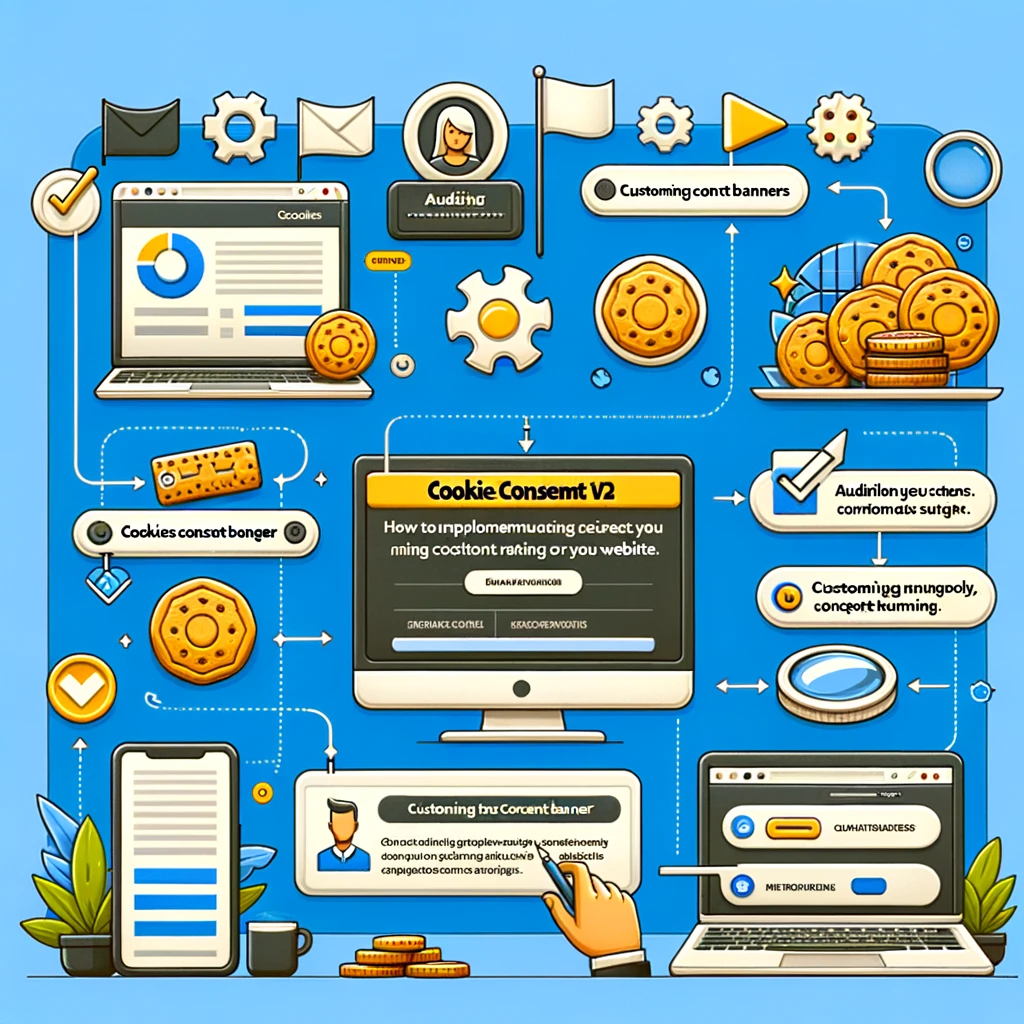
Implementing cookie consent is crucial for ensuring your website complies with privacy regulations and provides transparency to users about data collection practices. In this guide, we’ll walk you through the steps to implement Cookie Consent V2 on your website effectively.
Understanding Cookie Consent V2
Cookie Consent V2 is an updated framework designed to enhance user control over personal data collected via cookies. It provides a more transparent and user-friendly approach, ensuring that users are well-informed about the types of cookies used and their purposes. This framework aligns with regulations such as GDPR and CCPA, making it essential for businesses operating in regions covered by these laws.
Steps to Implement Cookie Consent V2
- Audit Your Website’s Cookies
- Start by identifying all the cookies your website uses. Categorize them into necessary, functional, performance, and targeting cookies. This audit is crucial for transparency and compliance.
- Choose a Consent Management Platform (CMP)
- A CMP helps manage user consents efficiently. It provides customizable consent banners and manages user preferences. Some popular CMPs include OneTrust, Cookiebot, and TrustArc.
- Customize the Consent Banner
- Design a consent banner that aligns with your website’s branding. Ensure it clearly explains the types of cookies used and their purposes. Provide options for users to accept all cookies, reject non-essential cookies, or customize their preferences.
- Implement the Consent Banner
- Integrate the consent banner on your website. Most CMPs offer easy integration with popular website platforms. Ensure the banner appears on the first visit and provides an option for users to change their preferences later.
- Configure Cookie Preferences
- Allow users to easily update their cookie preferences. This can be done through a “Cookie Settings” link in the website footer or within the consent banner.
- Update Your Privacy Policy
- Reflect the changes in your privacy policy. Include details about the types of cookies used, their purposes, and how users can manage their preferences. This enhances transparency and trust.
Best Practices for Cookie Consent Implementation
- Clear and Concise Messaging: Ensure your cookie consent banner uses simple language to explain the purpose of cookies.
- Regular Audits: Periodically review and update the list of cookies used on your website.
- User-Friendly Design: Make the consent process straightforward and user-friendly to avoid frustration.
Implementing Cookie Consent V2 not only helps in complying with legal requirements but also builds trust with your users by being transparent about data collection practices. For more insights on how to enhance your website, check out Sharefox Academy.
Benefits of Implementing Cookie Consent V2
Implementing Cookie Consent V2 provides numerous benefits for both your business and your users. Here are some key advantages:
- Compliance with Regulations: By implementing Cookie Consent V2, your website will comply with privacy regulations such as GDPR and CCPA, avoiding potential legal issues and fines.
- Enhanced User Trust: Transparency in data collection practices builds trust with your users. When users know how their data is being used and have control over their preferences, they are more likely to engage with your website.
- Improved User Experience: A well-designed consent banner that is easy to understand and use can enhance the overall user experience on your website. Providing options for users to manage their cookie preferences without hassle contributes to a positive experience.
- Better Data Quality: With explicit consent from users, the data collected through cookies is more reliable and relevant. This can improve the effectiveness of your marketing and analytics efforts.
- Customizable Options: Cookie Consent V2 allows you to customize the consent banner and settings according to your website’s needs. This flexibility ensures that you can maintain your brand’s look and feel while complying with regulations.
For more information on how to optimize your website’s user experience, visit our How to Add Videos and Images in Sharefox guide.
Challenges in Implementing Cookie Consent V2
While there are many benefits, implementing Cookie Consent V2 can come with its own set of challenges:
- Technical Integration: Integrating a consent management platform with your existing website infrastructure can be complex. It requires technical expertise to ensure smooth implementation.
- User Resistance: Some users may find consent banners intrusive or annoying. It’s important to design a banner that is not disruptive to the user experience.
- Continuous Monitoring: Privacy regulations and best practices are constantly evolving. Keeping up with these changes and ensuring your website remains compliant requires ongoing effort.
- Balancing Compliance and User Experience: Striking the right balance between regulatory compliance and maintaining a seamless user experience can be challenging. Overly complex consent mechanisms may deter users, while insufficient transparency may lead to compliance issues.
Tools and Resources
Several tools and resources can help streamline the implementation of Cookie Consent V2:
- Sharefox Rental Software: Our platform provides comprehensive solutions for managing your rental business, including tools for compliance and customer engagement. Learn more about our offerings on our homepage.
- Privacy Policy Generators: Tools like TermsFeed and PrivacyPolicies.com can help you create compliant privacy policies that reflect your cookie usage.
- Web Development Services: Hiring web developers with expertise in privacy compliance can ensure that your implementation is technically sound and effective.
For more guidance on enhancing your website and rental business, check out our About Us page.
Conclusion
Implementing Cookie Consent V2 is an essential step for ensuring your website complies with privacy regulations and maintains transparency with users. By following the steps outlined in this guide and utilizing the right tools and resources, you can create a user-friendly and compliant cookie consent experience.
Remember to regularly review and update your cookie consent mechanisms to keep up with changing regulations and best practices. For more tips and insights on optimizing your rental business, visit the Sharefox Academy.
How to Optimize Your Consent Banner
Optimizing your consent banner is crucial for balancing regulatory compliance with a seamless user experience. A well-designed consent banner can enhance user trust and ensure that you collect meaningful data. Here are some key strategies for optimizing your consent banner:
1. Clear and Concise Messaging
Use Simple Language: Avoid legal jargon and use clear, simple language to explain why cookies are used and what types of data are collected. This ensures that users of all backgrounds can understand your message.
Provide Essential Information: Clearly state the purpose of each type of cookie (e.g., necessary, functional, performance, targeting). This helps users make informed decisions.
2. User-Friendly Design
Prominent Placement: Place the consent banner in a prominent location on the screen without obstructing the main content. A common practice is to position it at the top or bottom of the page.
Easy Navigation: Ensure that users can easily navigate the consent options. Use buttons and links that are clearly labeled, such as “Accept All,” “Reject All,” and “Customize Preferences.”
3. Customization Options
Granular Control: Allow users to customize their cookie preferences at a granular level. Instead of a simple “accept” or “reject” choice, offer options for each category of cookies.
Persistent Settings: Include an option for users to change their cookie preferences at any time. A “Cookie Settings” link in the website footer is a good practice.
4. Visual Appeal
Consistent Branding: Match the design of the consent banner with your website’s branding. Use your brand colors, fonts, and style to create a cohesive look.
Responsive Design: Ensure that the consent banner is mobile-friendly and works well on all devices. A responsive design improves the user experience across different screen sizes.
5. Transparency and Compliance
Detailed Privacy Policy: Link to a detailed privacy policy where users can find more information about your data collection practices. Make sure this policy is easy to read and accessible.
Regulatory Updates: Stay informed about changes in privacy regulations and update your consent banner accordingly. Regular audits ensure ongoing compliance.
6. Testing and Optimization
A/B Testing: Conduct A/B tests to determine which banner designs and messages resonate best with your audience. Testing different variations can help you identify the most effective approach.
User Feedback: Collect feedback from users about their experience with the consent banner. Use this feedback to make continuous improvements.
7. Performance Monitoring
Analytics Integration: Integrate your consent banner with analytics tools to monitor its performance. Track metrics such as acceptance rates, rejection rates, and customization usage to gauge effectiveness.
For more detailed guides and best practices on optimizing your website, check out our How to Build a Stunning Frontpage article.
By implementing these optimization strategies, you can create a consent banner that not only complies with legal requirements but also enhances the user experience. This balance is key to building trust and collecting valuable data.
FAQ:
- What is Cookie Consent V2?
- Cookie Consent V2 is an updated framework designed to enhance user control over personal data collected via cookies, aligning with privacy regulations like GDPR and CCPA.
- Why is Cookie Consent V2 important?
- It ensures compliance with privacy laws, builds user trust, and improves the quality of data collected from users.
- How do I audit my website’s cookies?
- Identify all cookies used, categorize them into necessary, functional, performance, and targeting cookies to ensure transparency and compliance.
- What should be included in a consent banner?
- A consent banner should clearly explain the types of cookies used, their purposes, and provide options for users to accept, reject, or customize their preferences.
- How can I make my consent banner user-friendly?
- Use clear language, place it prominently, ensure easy navigation, and allow users to customize their cookie preferences.
- What tools can help with Cookie Consent V2 implementation?
- Consent management platforms (CMPs) like OneTrust, Cookiebot, and TrustArc, and web development services for technical integration.




